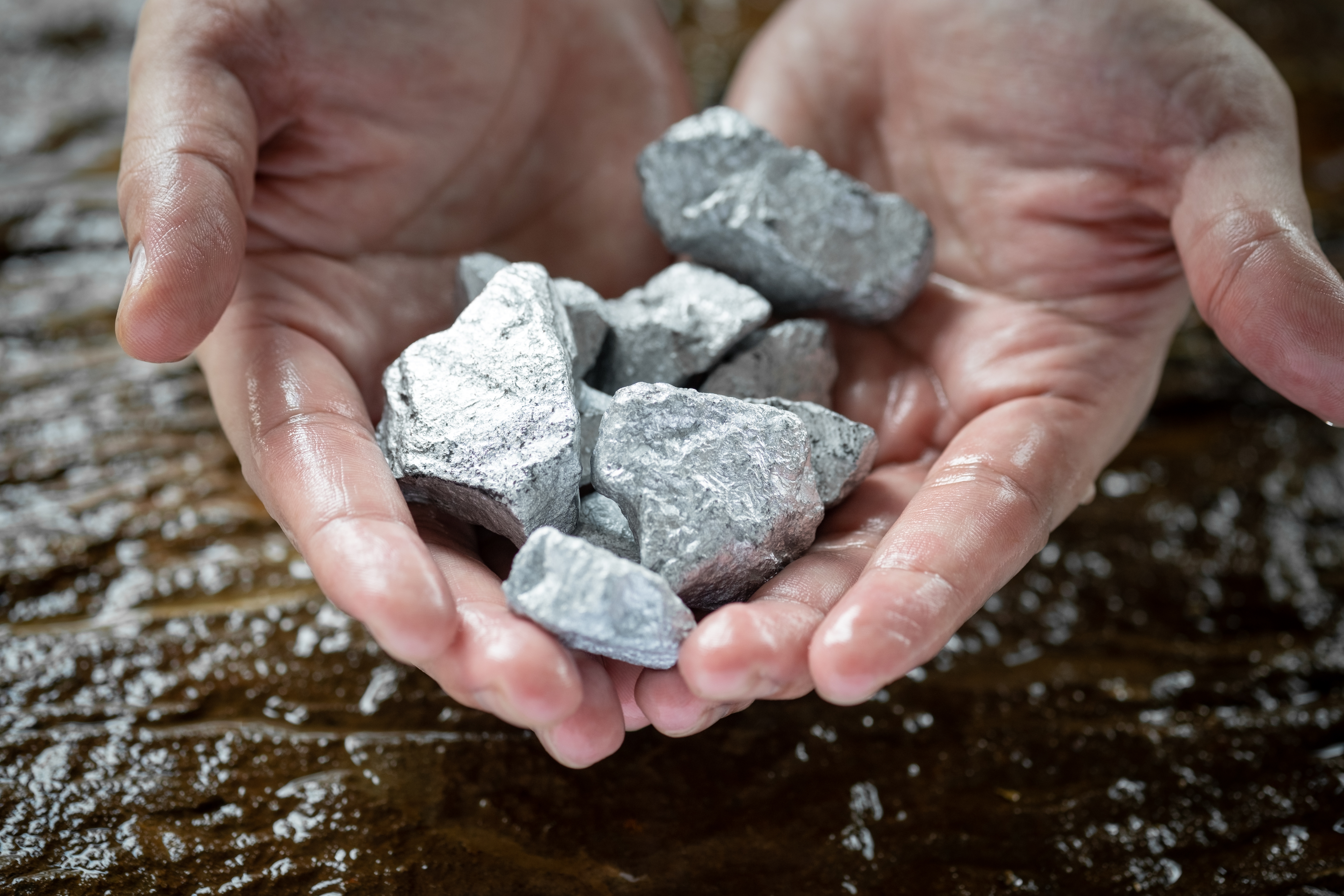The world is rapidly embracing digital and clean technologies like electric vehicles (EVs), hydrogen fuel cells, wind turbines, robotics’ traction motors, and solar photovoltaic (PV) panels. These technologies can help slow climate change, improve productivity, or connect millions of people around the world. But behind these complex technologies are many essential inputs like metals, minerals, and materials.
Rare earth materials are the critical but often unheralded basic ingredients fuelling the advancement of disruptive technologies. But because their extraction is a physical process and has natural limitations, supply chains for disruptive materials can face challenges that are uncommon in high-tech industries. Supply can be limited or delayed, capital requirements are high, and geographic features and local regulations can limit availability.
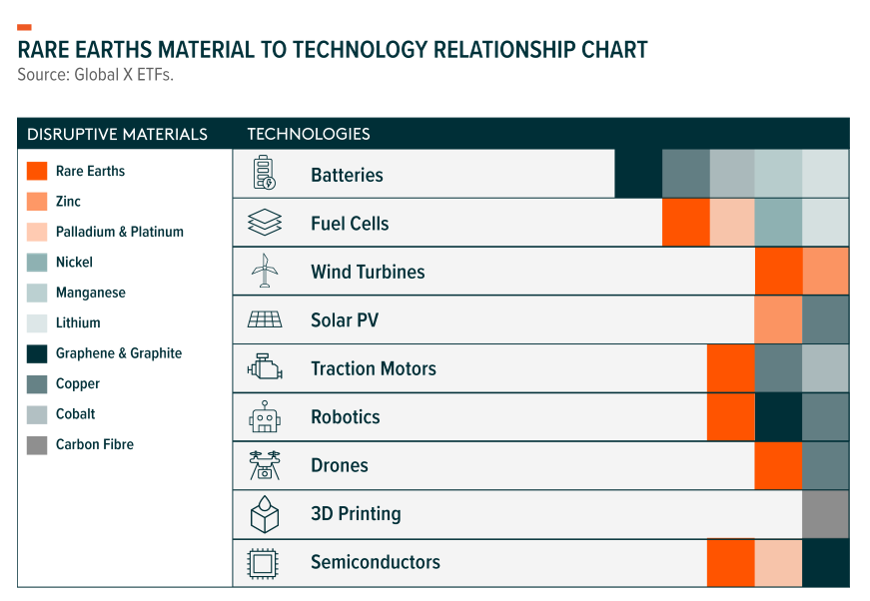
Materials prices tend to be highly correlated with global macroeconomic conditions. Most cycles tend to be shorter-term in nature, lasting anywhere from months to just a few years as economic conditions evolve. But supercycles are different. They are characterized by structural, decades-long periods of above-trend price movements. Historically, rapidly growing demand combined with persistent and insufficient supply creates the conditions for supercycles.
In our view, the simultaneous emergence of several game-changing technologies could create a similar condition for a supercycle in specific materials. For example, the transition from internal combustion engine (ICE) vehicles to EVs is poised to be a significant driver of demand for materials like lithium, graphite, copper, nickel, cobalt, and manganese. An EV requires six times more of these materials than a traditional ICE.1
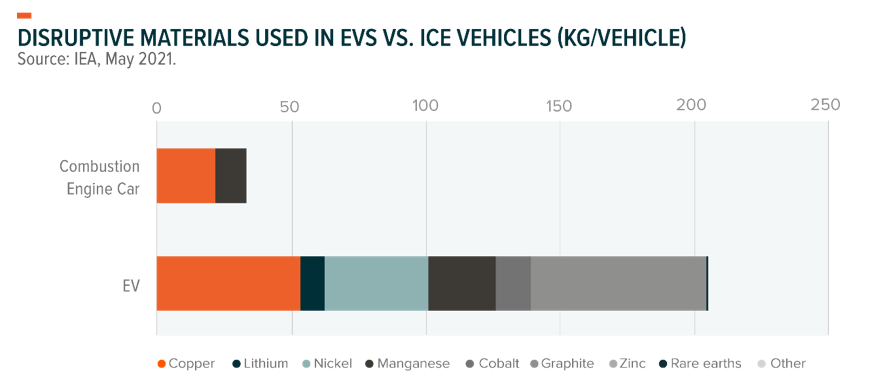
Clean technologies such as wind turbines and electric motors require rare earth minerals to manufacture permanent magnets such as neodymium, praseodymium, terbium and dysprosium.2 Global production of rare earth materials reached an estimated 280,000 tons in 2021, compared to 240,000 in 2020 and 220,000 in 2019.3 China accounted for 60% of total production in 2021, followed by the U.S., at 15%.4
Copper continues to gain importance because of the properties that make it a reliable conductor of electricity and heat and resistant to corrosion. Given that copper is much cheaper than precious metals with similar electrical conductivity, it is frequently the metal of choice for the generation, transmission, and distribution of electricity.
Graphene’s use in end-markets like automotive & transportation, aerospace, electronics, and construction is expected to grow too. Often described as a wonder material, graphene is the thinnest known material but also the strongest, being 100 times stronger than the strongest steel.5
Carbon fibre provides greater strength, stiffness, heat resistance, and durability than other 3D printed materials such as thermoplastics.6 Today, approximately 30% of all carbon fibre is used in the aerospace industry because of its extraordinary strength-to-weight ratio.7
Platinum has become a vital material for the electronics industry, especially hard disks. Platinum is also foundational for hydrogen fuel cells, as it is used as the catalyst that separates hydrogen into protons and electrons, which then generate an electrical current.8
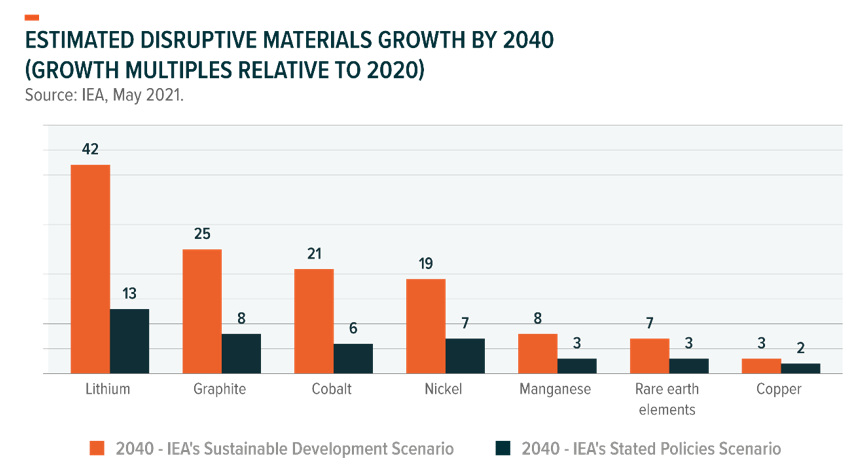
Many of the key demand drivers for disruptive materials are related to climate change and clean technologies. The International Energy Agency’s (IEA) climate change scenarios provide glimpses into potential demand for disruptive materials.
The IEA’s Stated Policies Scenario (STEPS) does not consider any significant measures beyond what policy makers had in place in 2021. In this scenario,
the IEA estimates overall demand for disruptive materials doubles by 2040 from 2020 levels.
9
The IEA’s Sustainable Development Scenario (SDS) assumes all current net zero pledges are achieved in full: developed economies reach net zero emissions by 2050, China around 2060, and every other country by 2070.
10
In this scenario, total demand for disruptive materials rises by 300% over the next two decades.
11
The IEA’s Net Zero By 2050 scenario is the best-case scenario for climate change.
I
n this scenario, the world gets to net zero emissions within the next three decades, a feat that would cause demand for disruptive materials to grow six times larger than 2020 levels.
12

Today, the disruptive materials theme is in its early stages amid structurally changing demand drivers for certain raw components. Several companies across the energy and materials sectors are looking to enhance their exposure to the space by buying mines, land, processing capabilities, and established companies involved in disruptive materials.
A traditional mining company like IGO Limited is in the process of divesting its gold mine interests and pursuing disruptive materials projects. Its $1.4bn lithium joint venture with Tianqi Lithium, Tianqi Lithium Energy Australia (TLEA), is one such project.13
In May 2022, First Quantum Minerals approved a $1.25bn expansion plan for its Kansanshi copper mine in Zambia. The project will increase copper production by an estimated 25%, with the mine set to run through 2044.14 The company also announced plans to develop a new $100m nickel mining project.15
Bringing additional supply of disruptive materials is hard, costly, and takes time. For example, lithium extraction can require three to five years or more of studies, permitting, capital raising, and capital expenditure before any lithium is produced. Other disruptive materials such as cobalt are only found in specific regions. The Democratic Republic of Congo (DRC) is the largest source of cobalt, accounting for 70% of global production.16
As companies move further into disruptive materials, we expect revenue profiles to shift significantly. According to one estimate, revenue from disruptive materials revenue could increase five-fold by 2040, reaching over $250bn, while mining coal revenues could decline by 59%.17
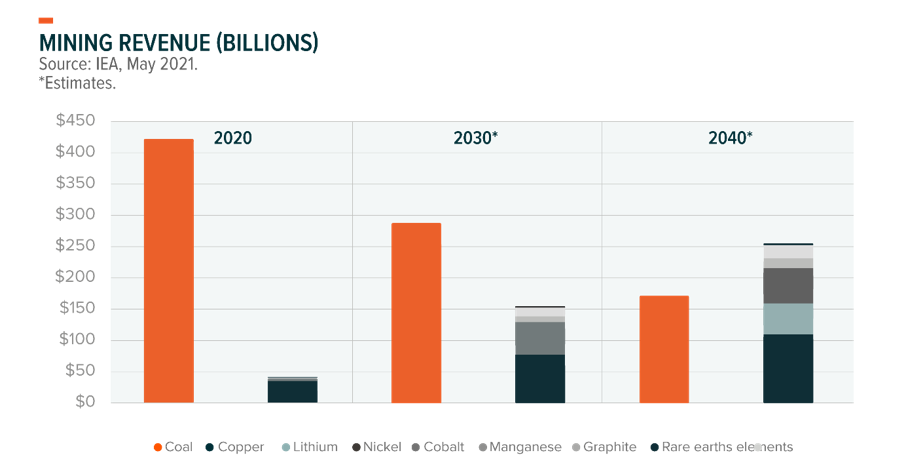
We believe the disruptive materials theme is an overlooked area in a decades-long shift towards digitalisation and clean energy. As technology continues to play an increasingly important role in all aspects of our lives, the fundamental ingredients for technology hardware are likely to become more and more critical. Given the physical limitations of mining, producing, and enhancing materials, however, we believe demand could structurally outstrip supply, resulting in a targeted supercycle and rising prices.
Investors with exposure to clean technology, electric vehicles and/or technology hardware may be wise to consider upstream exposures to the disruptive materials-related activities as well in an effort to gain broader exposure to the ecosystem of companies that may benefit from the rise of several emerging technologies.
International Energy Agency. (2021, May). The role of critical minerals in clean energy transitions. World Energy Outlook. https://www.iea.org/reports/the-role-of-critical-minerals-in-clean-energy-transitions
Alves Dias, P., Bobba, S., Carrara, S., & Plazzotta, B. (2020). The role of rare earth elements in wind energy and electric mobility, EUR 30488 EN. Publications Office of the European Union, Luxembourg. doi:10.2760/303258, JRC122671. https://publications.jrc.ec.europa.eu/repository/handle/JRC122671
Cordier, D. J. (2022, January). Rare Earths. United States Geological Survey, Mineral Commodity Summaries. https://pubs.usgs.gov/periodicals/mcs2022/mcs2022-rare-earths.pdf
Russell, J. (2019, May 8). Graphene surprises again, this time for quantum computing. HPC Wire. https://www.hpcwire.com/2019/05/08/graphene-surprises-again-this-time-for-quantum-computing/
(n.d.). 3D printing carbon fiber and other composites. Accessed on August 31, 2022 from https://markforged.com/resources/learn/design-for-additive-manufacturing-plastics-composites/understanding-3d-printing-strength/3d-printing-carbon-fiber-and-other-composites
IYRS School of Technology & Trades. (2021, March 12). The many exciting uses of carbon fiber in composites manufacturing. https://www.iyrs.edu/iyrs-blog/blog-details-page/~board/student-blogs/post/the-many-exciting-uses-of-carbon-fiber-composites
Wexler, A. (2021, March 25). Fuel-cell technology lets platinum miners shine again. The Wall Street Journal. https://www.wsj.com/articles/fuel-cell-technology-lets-platinum-miners-shine-again-11616677317
International Energy Agency. (2021, May). The role of critical minerals in clean energy transitions. World Energy Outlook. https://www.iea.org/reports/the-role-of-critical-minerals-in-clean-energy-transitions
International Energy Agency. (2021). Sustainable development scenario (SDS). https://www.iea.org/reports/world-energy-model/sustainable-development-scenario-sds
International Energy Agency. (2021, May). The role of critical minerals in clean energy transitions. World Energy Outlook. https://www.iea.org/reports/the-role-of-critical-minerals-in-clean-energy-transitions
Reuters Staff. (2021, June 30). IGO closes $1.4 billion deal for stake in Tianqi Lithium assets. https://www.reuters.com/article/us-tianqi-lithium-igo/igo-closes-1-4-billion-deal-for-stake-in-tianqi-lithium-assets-idUSKCN2E616I
Surran, C. (2022, May 9). First quantum minerals IKs $1.25B Zambia copper expansion. Seeking Alpha. https://seekingalpha.com/news/3834872-first-quantum-minerals-oks-125b-zambia-copper-expansion
Lithium Americas. (n.d.). Lithium Americas reports second quarter 2022 results [Press release]. https://lithiumamericas.com/news/lithium-americas-reports-second-quarter-2022-results
Benchmark Mineral Intelligence. (2022, January 7). Scale up of cobalt production needs ESG commitments to match. https://www.benchmarkminerals.com/membership/how-the-scale-up-of-cobalt-production-needs-esg-commitments-to-match/
This document is not intended to be, or does not constitute, investment research as defined by the Financial Conduct Authority.
The value of an investment in ETFs may go down as well as up and past performance is not a reliable indicator of future performance.
Trading in ETFs may not be suitable for all types of investors as they carry a high degree of risk. You may lose all of your initial investment. Only speculate with money you can afford to lose. Changes in exchange rates may also cause your investment to go up or down in value. Tax treatment depends on the individual circumstances of each client and may be subject to change in the future. Please ensure that you fully understand the risks involved. If in any doubt, please seek independent financial advice. Investors should refer to the section entitled “Risk Factors” in the relevant prospectus for further details of these and other risks associated with an investment in the securities offered by the Issuer.
